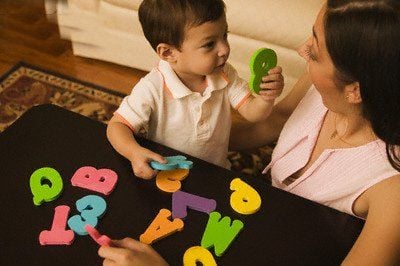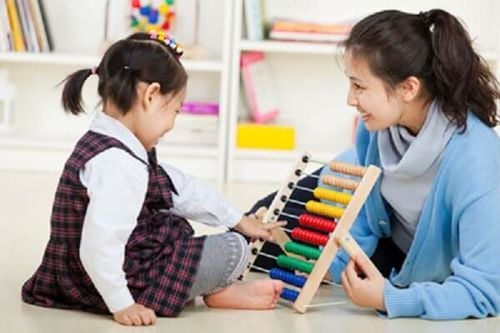This is an automatically translated article.
Posted by Bachelor Unit of Regenerative Medicine Clinic and Educational Psychology - Vinmec Times City International Hospital
Each child has very different skills and potentials. Your child may have skills at one stage and skills at another at the same time. It is important for parents to determine at which stage their child is gaining more skills and what skills parents need to develop for their child at the next stage.
1. The stages of communication development in children
1.1 The stage of involuntary communication This is the stage when children pay attention and care to stimuli from the surrounding environment such as: voices of caregivers, sounds, and sounds of objects. Children have the ability:
| Hiểu | Diễn đạt |
|
Nhìn khi người khác nói, cười Đôi khi phản ứng khi nghe gọi tên trẻ Quay về hướng có âm thanh Nhận ra giọng nói quen thuộc Hiểu cử chỉ quen thuộc: “bye bye, vẫy tay, không” |
Tiếng khóc khác nhau khi: Đói, đau, mệt Nhìn vào người/ vật trẻ thích Chơi với âm thanh “iii”, “aaa” Tạo âm thanh “iiii, aaa, baba, măm măm khi hóng chuyện Bắt chước âm thanh nghe được hoặc hành động đơn giản Nhắm mắt hay quay đầu khi trẻ không muốn |
>>> Normal neuro and motor development in children 5-15 years old
1.2 The stage of intentional communication This is the stage when children understand familiar words in the context. Use more gestures, initiate communication, imitate making sounds like words. Be proactive in starting and ending with others. Children have the ability:
| Hiểu | Diễn đạt |
|
Đáp ứng khi được gọi tên Hiểu tên đồ vật, quen thuộc trong sinh hoạt hàng ngày: bát, thìa, bàn,.. Đáp ứng với câu hỏi: ai?, cái gì? Hiểu yêu cầu một thành phần kèm cử chỉ: “ tạm biệt”, “ lại đây” Hiểu từ “cho” và thường xuyên ngừng lại hoạt động khi nghe từ “không” |
Kéo tay người lớn đến vật mà trẻ muốn Nhìn, chỉ về phía đồ vật trẻ muốn và nhìn lại bạn Yêu cầu bằng cách nhìn, cười, cử động cơ thể tạo ra âm thanh Bập bẹ “bababa”, “mamama” một cách có ý nghĩa Nói “mama”, “baba”, “măm măm” một cách có ý nghĩa , ví dụ nói “mama”để gọi mẹ Tạo âm thanh giống như từ : ước (nước), ơm (cơm) Dung cử chỉ như gật đầu để đồng ý, lắc đầu từ chối hoặc vẫy tạm biệt |
>>> Ways to encourage quiet children to communicate more
1.3 The stage when children say single words is the stage when children understand key words in a sentence in a familiar context. Use more single words, say more familiar words to express personal needs. Children have the ability:
| Hiểu | Diễn đạt |
|
Biết bộ phận cơ thể: mắt, mũi, miệng, tay hay đồ vật: đồng hồ, tivi Hiểu thêm từ mới mỗi tuần Hiểu cụm từ với từ khóa nằm giữa câu “con lấy áo cho mẹ”, “Bi ăn cơm” Làm theo yêu cầu một thành phần không kèm cử chỉ “ngồi lên ghế”, cầm muỗng lên”, “chào cô” Hiểu câu hỏi : có/không như: “con ăn chuối không?”, “ăn thêm không” Biết nhiều tên người thân, đồ vật, con vật |
Dùng lời nói nhiều hơn Bắt chước âm thanh: tiếng kêu con vật, tiếng còi xe Bắt chước nói từ Dùng được từ 3-50 từ đơn Sử dụng động từ: ăn, ngủ, uống Chỉ đồ vật quen thuộc khi được yêu cầu Đưa ra yêu cầu bằng cách dung cử chỉ, từ ngữ Dung nhiều cử chỉ, điệu bộ |
>>> Social cognitive development of children
1.4 The stage when children say word-combined words is the stage when children begin to use double words, short sentences in communication with many vocabulary words in other situations together. Children have the ability:
| Hiểu | Diễn đạt |
|
Hiểu thêm từ mới mỗi ngày Có thể hiểu đươc câu hỏi: Ở đâu?, khi nào?, tại sao? Làm theo yêu cầu hai thành phần “ lấy điện thoạn đưa cho ba” Biết nhiều bộ phận cơ thể hơn: má, cằm, rang, ngón chân” Hiểu đại từ sở hữu: “ của con” “của mẹ” Hiểu giới từ và tính từ: trong, ngoài, trên, dưới, lớn, nhỏ Hiểu được câu chuyện đơn giản |
Nói ít nhất 50 từ Biết đặt hoặc trả lời câu hỏi : “ai, cái gì, ở đâu Nói câu 2-3 từ: ăn cơm, đi ngủ, con uống nước Dùng tên riêng khi nói về mình : “Bi ăn”, “cho Bi”, “Bi xin” Sử dụng đại từ sơ hữu “của con”, “của mẹ” Sử dụng một vài tính từ: xinh, đẹp, bẩn, sạch Nói về chuyện đã hoặc sắp xảy ra Biết bày tỏ cảm xúc, giả vờ |
>>> How to develop language while playing with children?
2. Strategies to help children develop communication skills
Understanding the stages of children's communication development, parents need to have their own strategies to help their children develop communication skills. In which parents can use the following strategies: Set up interaction; Create communication opportunities; Language stimulation.
2.1 Set up interaction Sit at eye level with the child :
Let the child see facial expressions, eyes, mouth movements when parents speak. Parents can sit down, so that their eyes are at child's eye level. Pay attention to your child and give them more time to start communicating. Imitation:
Parents can imitate activities, sounds, facial expressions or words. Children will find us more interesting and attentive when we imitate them. Sometimes children will imitate us when we imitate their actions. For children who are indifferent to play, this skill has proven effective to get children involved in the games we initiate.
>>> Developing language for children through food
Alternate (take turns): In the game, parents will have to respond to the child and vice versa and the child must also respond to the parent. It is the alternation in communication. It is through this that two people can give and receive information. Communication can be just a look, a sound, a gesture, a word, a sentence, even a good story including all of them.
Listen: We pay attention to what the child is saying so that we can answer correctly. When we listen to children with a caring attitude, they feel that what they have to say is important and that encourages them to keep the conversation going. For children with communication difficulties, sometimes their words and actions seem meaningless, but in fact they all mean something. So if we continue to listen, children will feel we understand them better and they will perform better. If we do not really pay attention to what the child has to say, we will not be able to maintain communication with the child. Parents can completely create a communication if they pay attention to what the child is saying. Children always want to share with everyone. If parents regularly observe, listen and wait for opportunities for children, parents will help children develop language and communication skills.
2.2 Create opportunities for communication Keep objects “in sight, out of reach” of children: When children see objects but cannot reach them, parents should wait for children to ask (by looking, by gestures, by making sounds). sounds and uses words) and then give it to the child and name the object. Divide into small parts: Give the child a little, then wait for the child to ask for more, then the parent gives and calls the name, and so on repeat the activity continuously. Choice: Parents place two objects in front of the child, wait for the child to choose, then give it to the child and name the selected object. Intentionally doing wrong: Parents may pretend to do something wrong, then wait for the child to react by looking, using gestures, sounds, or using words, and finally the parent does the right activity and calls out the name. >>> Language - Speech - Communication and how to recognize children with language difficulties

2.3 Language stimulation Modeling: Parents speak clearly, slowly, using words appropriate to the child's level. Add new words and expand sentences. Repeat: Say the words. sentences that parents want children to say many times. Highlight key words: When speaking, parents pause for a moment, emphasize and clarify to highlight words and phrases that parents want children to learn. Talk about what's going on: Parents can describe the activity parent and child are doing, commenting on the action with short sentences. Fill in the blank: Parents can say/sing the sentence and leave blank the word you want the child to fill in. Wait for the child to speak and count silently for 5 seconds. Praise your child when he or she responds. Encourage: Parents should listen attentively, respond with words and gestures to let children know they are getting attention. Praise the child's efforts and efforts. Teaching children language through everyday activities is very effective and natural. Daily activities can be mentioned such as: eating, personal hygiene, taking children to school, walking, going to the park, entertainment, going to bed.
Please dial HOTLINE for more information or register for an appointment HERE. Download MyVinmec app to make appointments faster and to manage your bookings easily.













